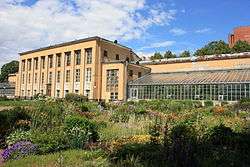Saint Petersburg Botanical Garden
Coordinates: 59°58′12″N 30°19′26″E / 59.97°N 30.324°E

The Saint Petersburg Botanical Garden, also known as the Botanic Gardens of the Komarov Botanical Institute or the Komarov Botanical Garden, is the oldest botanical garden in Russia. It consists of outdoor and indoor collections situated on Aptekarsky Island in Saint Petersburg and belongs to the Komarov Botanical Institute of the Russian Academy of Sciences. It is 18.9 ha in area, and is bordered by Aptekarsky Prospekt (main entrance), Prof. Popov Street (second entrance), as well as the embankments of the Karpovka and Bolshaya Neva rivers.
Overview
The garden was founded by Peter I in 1714 as a herb garden in order to grow medicinal plants and re-established as a botanical institution under the name Imperial Botanical Garden in 1823. Ivan Lepyokhin was in charge of the botanical garden from 1774 until 1802. Beginning in 1855, Eduard August von Regel was associated with the garden, first as Scientific Director and then as Director General (1875-1892). Regel had a particular fascination with the genus Allium, overseeing collections of these plants in the Russian Far East and writing about them in two monographs. More than 60 of the alliums he identified bear his name, e.g., A. giganteum Regel and A. rosenbahianum Regel.[1] Many alliums can be viewed in the Northern Yard of the garden. In 1897, Konstantin George Alexander Winkler(14 June 1848 - 3 February 1900), became head botanist at the Garden. He then reorganized the herbaria and greenhouse collections.[2] Around 1900, Boris Fedtschenko became head botanist and he organised investigations of various Russian regions including Siberia, Caucusus, Middle Asia and Asiatic Russia. All published in various volumes and books.[3][4]
In 1930, the garden became subordinate to the Academy of Sciences of the Soviet Union and, in 1931, was merged with the Botanical Museum into the Botanical Institute.
Greenhouses
The garden has 25 greenhouses constructed in 1823-1824. They are numbered from 1 to 28 (No. 5 and No. 25 don't exist; No. 10 and No. 11 are shared). Some of them are open to the public (guided visits only), including the large collections of azaleas and other Ericaceae (No. 6), ferns (No. 15), cacti and other succulents (No. 16), various tropical plants (No. 18), the 23.5 m high Big Palm Greenhouse with an important collection of orchids (No. 26) and the greenhouse with a pond containing Victoria amazonica (no. 28). The night blossom of cactus Selenicereus grandiflorus, cultivated there since 1857, is a celebrated event announced in mass media and open to the public in the 16th greenhouse in June-July. The indoor collections suffered significant losses during the Siege of Leningrad in 1941-1944; out of 6367 species only 861 survived.
The chain of greenhouses encircles the Southern Yard and the Northern Yard, the latter featuring an extensive outdoor collection of Iridaceae and bulbous plants, including many species of Allium. The building of the botanical museum faces the Northern Yard in place of the non-existent greenhouse No. 5.
Park
The outer park includes a small rock garden (constructed in the end of the 19th century) located in front of the Big Palm Greenhouse, and a 0.16 km² arboretum, organized partly as an English garden and partly as a formal garden. The park, unlike the greenhouses, is closed for visitors from October 1 to May 8. It is elevated only 1.5-3 m above sea-level and has thus regularly suffered from catastrophic floods characteristic of Saint Petersburg. The herbarium edifice built in 1913 stands in front of the main entrance.
Images






See also
-
 Russia portal
Russia portal -
 Gardening portal
Gardening portal
References
- ↑ Block, E. (2010). Garlic and Other Alliums: The Lore and the Science. Royal Society of Chemistry. ISBN 0-85404-190-7.
- ↑ Walther Killy (editor)Dictionary of German Biography Thibaut - Zycha, Volume 10, p. 555, at Google Books
- ↑ "Fedtschenko, Boris Alexjewitsch (Alexeevich) (1872-1947)". plants.jstor.org. Retrieved 1 October 2014.
- ↑ David G. Frodin Guide to Standard Floras of the World: An Annotated, Geographically Arranged , p. 658, at Google Books
Sources
- Путеводитель по оранжереям Ботанического сада. Тропики. / Отв. ред. Н.А. Аврорин и Н. Н. Имханицкая. – Leningrad: Nauka, 1978.
- Ботанический сад. Leningrad: Lenizdat, 1989.
- Соколов В.С., А.А. Федорова. Ботанический институт имени В. Л. Комарова Академии наук СССР. Leningrad, 1947.
- От аптекарского огорода до Ботанического института. Leningrad: Изд-во АН СССР, 1957.
- BGCI: Arboretum of Komarov Botanical Institute in Saint Petersburg, Russia
External links
- Botanical collections of Russia and the adjacent states. Database (designed for Internet Explorer only)